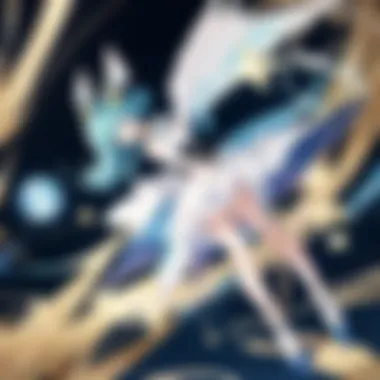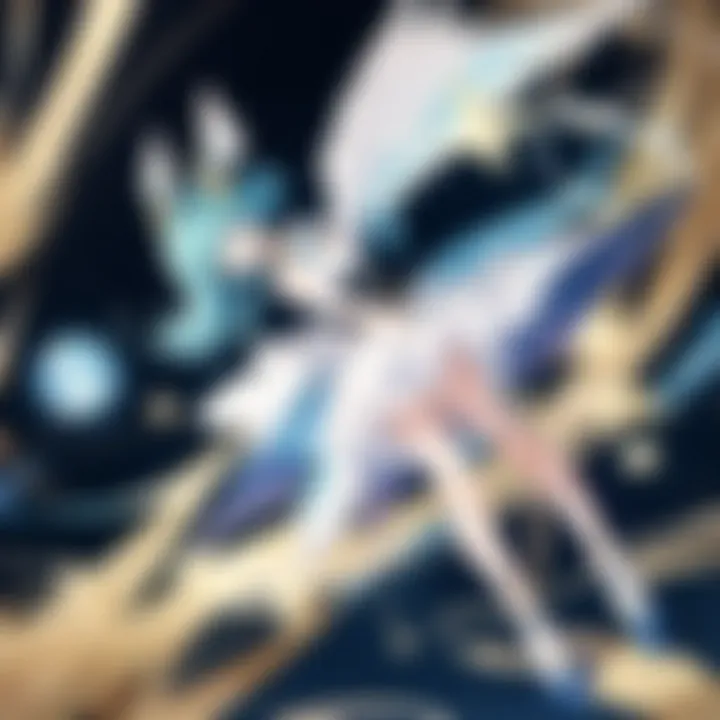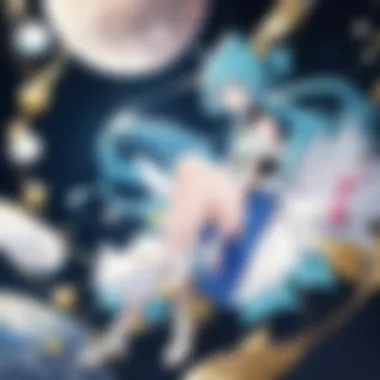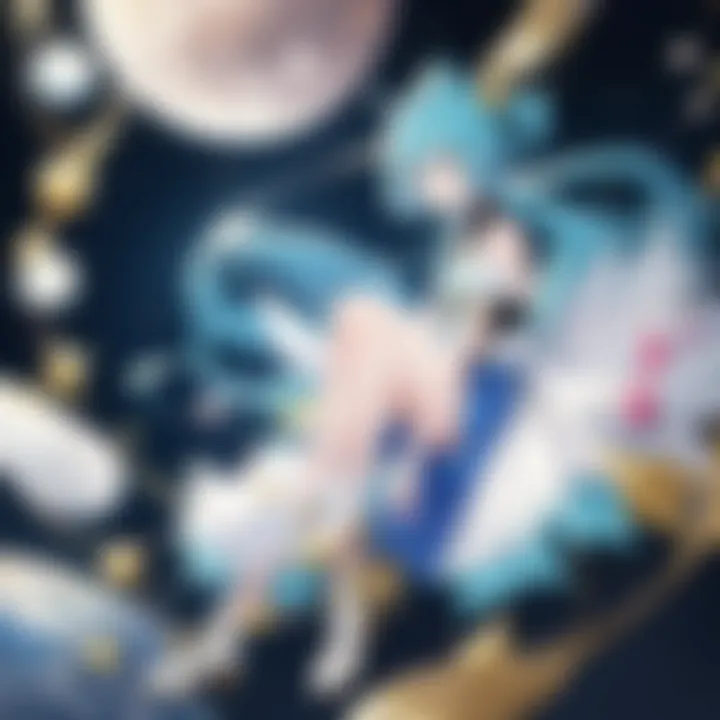Exploring Pokémon from the Moon: A Comprehensive Analysis


Intro
The Pokémon franchise has consistently captivated audiences worldwide since its inception, blending elements of adventure, strategy, and mythology. With each new installment, creativity and innovation flourish, leading to a vast universe filled with creatures inspired by every aspect of life and culture. Among these, the Pokémon from the Moon version stand out due to their unique traits and the thematic depth they offer.
This article aims to provide an insightful exploration of the Pokémon featured in the Moon version, analyzing their aesthetics, backstories, gameplay roles, and broader significance within the series. By dissecting the nuances of these celestial-themed creatures, we can uncover the layers of lore that enrich the world of Pokémon. Additionally, this examination will reflect on the overarching themes of exploration and astonishment that resonate through the franchise, shedding light on the connections between the Pokémon universe and celestial bodies.
Character Profiles
Overview of Main Characters
Within the Moon version, several Pokémon emerge as central figures, each showcasing distinct abilities and captivating designs. These main characters often mirror the celestial theme, embodying elements associated with the moon or night sky.
- Lunala: A notable Legendary Pokémon representing the moon itself. Lunala is characterized by its majestic wings and psychic abilities. Its lore speaks of its ability to guide lost souls, reinforcing themes of protection and guidance. It is revered not only for its power but also for the elegance it brings to gameplay.
- Cosmoem: Serving as the pre-evolution of Lunala, Cosmoem is a mystery wrapped in cosmic power. Its shape, reminiscent of a duality, symbolizes the relationship between time and space. This Pokémon plays a crucial role in the narrative progression, linking players to larger cosmic themes.
- Clefairy: Often associated with moonlight in folklore, Clefairy adds a whimsical element to the roster. Its playful nature and fairy-type classification provide balance to the more serious tones established by Legendary Pokémon.
Supporting Characters
In addition to the main characters, various supporting Pokémon play vital roles, enriching the player's experience and narrative depth.
- Sableye: Its ghostly features and mischievous temperament make it an intriguing part of the gameplay. Sableye thrives in the moonlit environment, creating a sense of mystery around it.
- Drifloon: This balloon-like Pokémon fits well within the lunar theme, embodying the floating and ethereal quality often attributed to the night sky. Its ghost-type attributes invoke a sense of curiosity, further enhancing the ambiance of the exploration framework.
Theme Exploration
Central Themes
Exploring Pokémon from the Moon delves into themes such as exploration, enlightenment, and duality. Each Pokémon embodies a piece of the cosmos, presenting players with a narrative that expands their understanding of their place in the universe.
"The Pokémon universe invites players to explore not just the world around them but also the deeper connections they forge with the myriad creatures they encounter."
Cultural References
The Pokémon landscape is rich with cultural references, many drawing from mythologies related to the night and celestial bodies. For instance, Lunala's lore aligns with various lunar deities found in world cultures, emphasizing connections to the divine and the nocturnal. These references assist in creating a more immersive experience for players while highlighting the intersection of gaming, culture, and mythology.
Popular Series and Recommendations
Top Anime Series of the Year
Pokémon continues to inspire other media, including anime and manga. For enthusiasts wishing to explore parallel narratives, the following series are highly recommended for their imaginative storytelling and character depth:
- Attack on Titan: Known for its intricate plot and character development, this series explores themes of survival and humanity that resonate well with the Pokémon narrative framework.
- My Hero Academia: With its emphasis on heroism and identity, this anime parallels the journey of Pokémon trainers discovering their unique abilities.
Hidden Gems in Manga
In addition to mainstream anime, numerous manga series echo similar themes of adventure and character exploration:
- Made in Abyss: This series captivates with its focus on exploration and discovery, linking closely to the Pokémon theme of journeying through unknown territories.
- Dorohedoro: Known for its unique art style and compelling narrative, it provides a vivid exploration of identity and transformation, resonating with the evolution mechanics found in Pokémon.
Through this analysis, the intricacies of the Pokémon from the Moon version come into sharper focus, illuminating their importance not only in gameplay but also in the larger narrative traditions of the Pokémon series.
Preamble to Pokémon from the Moon
The Pokémon Moon version expands the established lore and gameplay mechanisms of the Pokémon franchise, introducing notable elements that resonate deeply with fans and newcomers alike. This section serves to underline the significance of lunar-themed Pokémon within the broader tapestry of the series. The incorporation of these characters not only enriches the gameplay experience but also invites exploration of themes related to the cosmos and mythology. By delving into Pokémon from the Moon, we can understand their impact on narratives, player strategies, and cultural connections.


Historical Context of Pokémon Games
The Pokémon franchise began with its release in 1996. Over the years, it has seen numerous iterations and generations, each adding layers to its complexity. Historical context plays a crucial role in appreciating the Pokémon Moon version. The introduction of lunar-themed Pokémon reflects a growing trend in video games, where celestial bodies serve as significant elements in storytelling and game design. As game mechanics evolved, so did the lore of individual Pokémon, leading to richer narratives.
Key milestones in Pokémon history include the introduction of legendary Pokémon, which typically embody unique themes or concepts. With the emergence of Pokémon Sun and Moon, there was a deliberate effort to celebrate Hawaiian culture and celestial mythology. This cultural backdrop informs the aesthetics and abilities of the Pokémon introduced in these games, illustrating a deeper understanding of character creation and thematic exploration.
Overview of Pokémon Moon
Pokémon Moon presents an immersive and unique adventure set in the Alola region, characterized by its distinct landscapes and cultural elements. It offers players a different perspective when compared to its counterpart, Pokémon Sun. The story unfolds with significant emphasis on exploration and discovery, reinforcing the theme of celestial influence.
In this version, the lunar cycle influences gameplay mechanics and Pokémon abilities. For instance, certain Pokémon may exhibit enhanced powers during nighttime conditions, highlighting the dynamic interactions between players and their environment.
Additionally, Pokémon Moon introduces new Pokémon, many of which possess lunar-related characteristics, further anchoring their identity within the cosmic framework. An example is Lunala, which embodies various lunar motifs, and serves as a focal point for the game's overarching narrative.
In summary, the introduction of Pokémon from the Moon enriches the lore of the franchise. They provide players with fresh perspectives on existing mechanics and reveal deeper connections to cultural storytelling. The analysis of these Pokémon reveals not just their gameplay significance but also their role in shaping players' engagement through thematic representation and narrative depth.
Significant Pokémon Introduced in Moon
The introduction of specific Pokémon in the Moon version serves as a pioneering aspect that enriches the franchise. Each Pokémon carries its own lore, type dynamics, and significance not just in gameplay, but also in broader narratives. This aspect is vital for understanding how the Moon version stands apart from others. These Pokémon embody new strategies, aesthetics, and cultural references which contribute to the ongoing evolution of the franchise. The uniqueness of these introductions can elevate the game for players while providing fresh experiences.
Lunala: The Legendary Pokémon
Design and Aesthetics
Lunala is notable for its striking appearance, resembling a large, bat-like creature with a dominating presence. This design mirrors the celestial theme that the Moon version embraces. Its color scheme, primarily featuring deep blues and purples, evokes the vastness of space. Lunala’s design choice speaks to the overall theme, making it an appealing figure in the Pokémon universe. The integration of geometric patterns adds an ethereal quality, enhancing its mystique. This design has become a hallmark for the franchise, attracting fans who appreciate aesthetic details in character development.
Moveset Overview
The moveset of Lunala includes unique abilities like Moongeist Beam, highlighting its connection to lunar power. This key characteristic showcases how moves can be more than just battle tactics; they provide narrative depth. The signature moves lend Lunala prestige and utility, being beneficial in various battle scenarios. Its glowing move animations underscore the quality of graphical presentations in the game. Therefore, it enriches both tactical and visual gameplay experience, appealing to players who value both function and flair.
Role in the Narrative
In terms of story, Lunala plays a pivotal role, often depicted as a protector within the celestial realm. Its presence significantly impacts the overarching narrative of the Moon version, positioning it as a guardian figure within the lore. This characteristic adds layers to the plot, giving players a reason to invest emotionally in Lunala's journey. The relationships Lunala builds with other characters enrich the storyline, making the game more immersive. Thus, the character formation complements the gameplay experience while enhancing engagement with the lore.
Cosmoem: Evolution and Mechanisms
Evolutionary Line
Cosmoem's evolutionary line is interesting as it translates the concept of transformation into gameplay. Starting from Cosmog, it evolves into Cosmoem, and ultimately into either Lunala or Solgaleo. This journey represents the cycle of life and transformation, aligning with the themes of exploration. Its two possible evolutions entice players with choices that affect game outcomes, making it a compelling aspect of strategy. This layer of complexity engages players who enjoy strategic planning and role-playing.
Role in Gameplay
In gameplay, Cosmoem serves as a pivotal piece in competitive battles. Its ability to evolve into two forms creates unique strategies, appealing to competitive players. This versatility enriches the gameplay landscape by allowing different tactics and team compositions. As players learn to navigate its strengths and weaknesses, the character fosters an environment for growth and mastery. Cosmoem thus represents a dynamic aspect of gameplay while catering to various player styles.
Lore Interpretation
From a lore perspective, Cosmoem is often linked to cosmic phenomena and celestial events. Its association with creation myths and the origins of Pokémon creates an enriching narrative framework. The interpretation of its lore can shape player perceptions, making them consider larger themes within the game world. This character enables deeper engagement with the narrative, as players reflect upon the significance of existence and transformation throughout the Pokémon universe.
Other Notable Pokémon from Moon
Types and Features


The types and features of other Pokémon introduced in the Moon version combine to add diversity to gameplay. Each new Pokémon comes with its own unique abilities and typings. This variety introduces new strategies and counters to traditional gameplay styles, enriching player choices. For example, Pokémon like Sableye and Oricorio use dual typings for more versatile battle strategies. These aspects cater to competitive players seeking to maximize efficiency and effectiveness.
Impact on Game Mechanics
The impact on game mechanics from new Pokémon is profound. Features like new abilities can redefine strategies within battles. Enhanced mechanics provoke shifts in how players approach fights, influencing team structures and game meta. For instance, moves like Z-moves amplify dynamics across competitive play, creating fresh yet meaningful experiences. Thus, these elements contribute significantly to maintaining player interest and enthusiasm over time.
Cultural Resonance
Culturally, Pokémon from the Moon version resonate with broader themes found both in mythology and popular culture. Their designs and stories reflect a fusion of Lunar mythology and modern gameplay trends. For example, characters echo celestial bodies' complexities, marrying idea with interactivity. This resonance enhances the connection players feel with the game, as they draw parallels to cultural narratives. Players engage more deeply when they see their favorite characters reflect themes that matter in their world.
Throughout the exploration of Pokémon from the Moon, it is essential to consider how every element interplays in creating a richer experience for the audience. From design to gameplay mechanics, each facet works to enhance the overall narrative.
Design Inspiration and Themes
The design inspiration and thematic elements in Pokémon from the Moon serve as vital threads that weave together the entire narrative and gameplay experience. This section explores how these inspirations not only shape the artistic direction of the Pokémon but also influence player engagement and interaction. By examining the sources from which the designs draw, we can uncover deeper meanings and resonances within the game. The interplay of lunar symbolism and myths offers a richer context for understanding these Pokémon, enhancing the overall experience for players.
Lunar Symbolism in Pokémon
Lunar symbolism in Pokémon is a central aspect of its identity in the Moon version. The moon itself has long been associated with mystery, change, and the night sky. These themes are inherent in the designs of various Pokémon, particularly Lunala, which embodies the essence of the moon. Lunala features luminescent colors and ethereal forms that reflect both beauty and enigma. This design choice not only stands out aesthetically but also aligns seamlessly with the symbolic power of the moon in various cultures.
The integration of lunar motifs extends beyond superficial aesthetics. Pokémon like Cosmoem represent transformation, encapsulating the moon's cyclical nature and the idea of phases. The moon influences tides and rhythms, mirroring how certain Pokémon abilities and moves reflect changes in gameplay dynamics. This synergy suggests that the lunar theme is not just a backdrop but a core element of the game’s design philosophy.
Folklore and Mythological References
Folklore and mythological influences are prevalent in the character designs of Pokémon introduced in the Moon version. Many creatures draw inspiration from various mythologies, representing themes such as guardianship and celestial travel. For instance, Lunala mirrors the role of a celestial guardian, resonating with tales of lunar deities across cultures. In Hawaiian mythology, the moon has influenced agriculture and navigation, which speaks to the relational aspects between nature and these themed Pokémon.
Moreover, the inclusion of mythological references adds layers to the narrative experience. Players encounter Pokémon that not only entertain but also evoke curiosity about the stories behind their designs. Understanding these references can enhance player engagement as they explore connections between Pokémon lore and cultural heritage.
'The designs of Pokémon embody deep-rooted cultural symbols that enrich the gameplay experience, inviting explorers to engage with the stories they tell.'
Impact on Gameplay and Strategy
The impact on gameplay and strategy within Pokémon Moon is significant. The introduction of new Pokémon, abilities, and gameplay mechanics adds layers of complexity to battles and team formations. Understanding these aspects enhances players' experience and performance in both casual and competitive settings.
New Moves and Abilities
The Pokémon from Moon brought with them a range of new moves and abilities that reshaped traditional combat mechanics. Notable abilities like Psychic Surge, introduced by Lunala, helped define a new era of strategizing. This ability creates an effect that boosts Psychic-type moves, making attackers more formidable than ever.
Additionally, moves such as Photon Geyser offer unique advantages. With its dual-type attack depending on the user's higher stat, it allows for flexibility in battle. Pokémon trainers must adapt their strategies by incorporating these new elements, forming team compositions that leverage their strengths and counteract weaknesses. This encourages deeper tactical planning and foresight in battles.
Competitive Play and Tier Rankings
In the realm of competitive Pokémon play, the introduction of these lunar creatures has triggered shifts in tier rankings. Certain Pokémon have gained prominence in competitive formats, influencing meta-game dynamics. For instance, Lunala's powerful presence has placed it in higher tiers due to its exceptional stats and game-changing abilities.
- Tier 1 Pokémon: These are often the foundation of competitive teams. They dominate the play due to their strong abilities and moves.
- Tier 2 Pokémon: While still competitive, they might require specific team supports or strategies to excel.
- Tier 3 Pokémon: These can be effective but lack the universal strengths of higher tiers.
This stratification reflects an evolving understanding of gameplay, where players must be aware of the strengths and weaknesses of their Pokémon. In summary, Pokémon Moon has expanded the gameplay landscape through innovative moves and abilities, significantly enhancing strategic depth.
"The incorporation of new abilities and moves requires trainers to continuously adapt their strategies, making Pokémon battles more dynamic and engaging."
Pokémon Interactions with Other Regions


The interactions between Pokémon from the Moon version and other regions are significant for understanding the overall structure and lore of the Pokémon universe. These interactions provide context and depth to the Pokémon's existence and their role within the larger narrative. Regions like Alola, with their unique ecosystems and habitats, influence how these lunar-themed Pokémon integrate into gameplay and strategy. Understanding these connections can enhance the appreciation of the Pokémon franchise, revealing how design elements and lore overlap across generations.
Link to Alola Region
The Alola region serves as a pivotal link for the Pokémon introduced in the Moon version. Alola's ecosystem is vibrant, characterized by its diverse biomes and cultural influences inspired by Hawaii. This region not only provides a habitat for Pokémon but also deepens the lore associated with them. For instance, Lunala, the Legendary Pokémon, embodies aspects of the lunar symbolism well appreciated in Alolan culture.
In gameplay, the Alola region introduces unique mechanics such as Alolan forms. These adaptations can affect strategies involving Pokémon from Moon. By merging regional characteristics with the celestial themes prominent in Moon, players gain access to various tactical opportunities in battle. Strategic interactions, influenced by both environment and lore, challenge trainers to think critically about their Pokémon choices.
- Example: An Alolan Raichu, being an Electric/Psychic type, may synergize well with Lunala in battle due to coverage against Fighting-type opponents.
Cross-Generational Connections
Cross-generational connections between Pokémon from Moon and those introduced in earlier or later versions provide a rich tapestry for lore expansion. The evolution of such connections fosters a deeper understanding of character development throughout the franchise. Pokémon from different generations often share common threads, whether through lineage, abilities, or thematic elements.
One notable connection can be observed with Cosmoem, which stands as a bridge between generation VII and other legendary Pokémon. For example, its evolution into either Lunala or Solgaleo is influenced by the player’s choices, reflecting a larger theme of dualities that appears throughout Pokémon lore.
- This aspect encourages trainers to engage with the Pokémon franchise differently, exploring various paths and connections.
- Notably: The ability for trainers to trade or battle across generations adds another layer, connecting communities and fostering a sense of unity among players.
"Cross-generational Pokémon like Cosmoem illustrate the franchise's commitment to continuity while exploring new thematic directions."
Ultimately, recognizing these connections allows fans to appreciate the holistic design of the Pokémon universe. It speaks to how Pokémon lore evolves constantly while retaining the allure that long-time players cherish.
Cultural Significance of Pokémon from Moon
The Pokémon introduced within the Moon version have not only provided players with new creatures to encounter and train but also contributed significantly to the cultural landscape surrounding this franchise. Their cultural significance lies in various aspects, influencing fan engagement and extending beyond the game itself.
Fan Reception and Community Engagement
The reception of Pokémon from the Moon has been largely positive. Fans embraced the unique designs and lore of these characters. Discussions and fan theories flourished on social media platforms like Reddit and Facebook. Players enjoyed sharing their experiences and strategies related to the Moon-exclusive Pokémon, enhancing the community's sense of belonging.
Interactions emerged through fan art, cosplay, and online forums. This communal engagement fostered a deeper connection to the franchise. For example, Lunala, as a prominent character, sparked both admiration and creative expression. Fans were drawn to its ethereal design and complex lore, leading to various discussions about its impact on the overarching story of the Pokémon series. Such conversations often highlight how Pokémon can extend their reach, becoming a part of broader cultural dialogues among fans.
Merchandising and Popularity
Merchandise surrounding Pokémon from the Moon has further solidified their cultural significance. Items ranging from plush toys to memorabilia celebrate these lunar-themed creatures. The demand for collectibles can be traced back to the characters' unique appeal and the narrative they contribute to the Pokémon universe.
In addition, major retailers have recognized the popularity of these Pokémon, resulting in strategic partnerships and limited releases. For instance, the success of Cosmoem-themed products illustrates how the markets respond to fan favorites. Pokémon Company International has also utilized community feedback to create merchandise that resonates with fans, proving that the cultural significance of these characters extends into the commercial realm.
Furthermore, the cultural footprint of Pokémon from the Moon intertwines with the game's enduring legacy. By introducing new themes and engaging narratives, these creatures contribute to the franchise's longevity and relevance in popular culture.
"Pokémon not only provides an escape into fantastical worlds but encourages a collective experience among fans."
This phenomenon illustrates how Pokémon from the Moon serve not just as game elements, but as cultural icons that promote community engagement and commercial success.
Ending
The conclusion brings together the various strands of analysis presented throughout this article. Understanding Pokémon from the Moon requires a comprehensive look at their unique traits and the broader implications these characters hold within the franchise. This section serves to reinforce key takeaways while paving the way for what the future may hold in Pokémon lore.
Summary of Findings
In analyzing the Pokémon presented in the Moon version, several important findings emerge. The addition of lunar-themed Pokémon like Lunala and Cosmoem introduces new dynamics to gameplay. These Pokémon not only boast unique designs and abilities but also reflect intricate connections to themes of exploration and celestial bodies found within the series. Furthermore, the reception from fans indicates a strong cultural resonance. Players deeply engage with these characters, often linking personal experiences to the broader narrative of discovery in the Pokémon universe.
Future Directions for Pokémon Lore
Looking ahead, the lore surrounding Pokémon from the Moon holds much potential for expansion. As the franchise continues to evolve, we may expect deeper storytelling that incorporates lessons learned from moon-themed characters. Future games could explore more interdisciplinary connections to astronomy, mythology, and even cultural folklore. New Pokémon may emerge, offering additional narrative layers and gameplay mechanics. This ongoing evolution of Pokémon lore speaks to the adaptability of the franchise, ensuring that it remains relevant and engaging for its audience.
"The exploration of Pokémon from the Moon signifies a broader journey into the uncharted territories within the franchise itself."
The continual development of Pokémon will not only enrich the gaming experience but also deepen fan engagement, assuring that the Moon's influence stretches far beyond its celestial allure.







